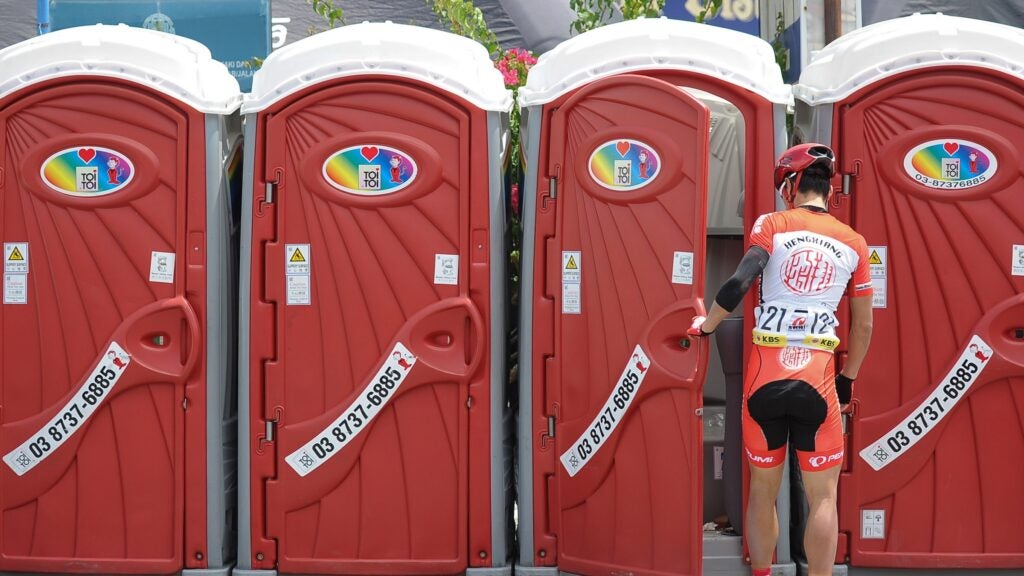No products in the cart.
Outdoor Adventure
Maybe Running Isn’t Harder on Your Gut than Cycling After All
Outside’s long reads email newsletter features our strongest writing, most ambitious reporting, and award-winning storytelling about the outdoors.
There’s a reason they call it “runner’s trots” and not “cyclist’s trots.” Running is notorious for triggering gastrointestinal distress—just ask Paula Radcliffe, whose live-on-TV pitstop at the 2005 London Marathon is the most famous example of a phenomenon that plays out every weekend at races and training runs around the world.
It’s usually blamed on the bouncing and jostling of your guts with each stride. But is that really what’s going on? After all, other endurance sports with less impact certainly aren’t immune: pro cyclist Tom Dumoulin lost more than two minutes to an unscheduled unloading during Stage 16 of the 2017 Giro d’Italia, whose overall title he somehow still managed to win. A new study in the Journal of Science and Medicine in Sport directly compares the GI impact of running and cycling under matched conditions, and finds the differences aren’t as big as you’d expect—which, in turn, sheds light on what the real triggers are.
The study was led by Ricardo Costa of Monash University in Australia, who has been among the leaders in defining and studying what he and his colleagues refer to as exercise-induced gastrointestinal syndrome. The syndrome is characterized by problems with your gut lining, which is supposed to allow food to pass into your bloodstream while blocking bacteria and toxins. When the lining malfunctions, food can’t get through (which ultimately triggers GI problems like nausea, gas, and the urge to defecate) and toxins can (which triggers inflammation throughout the body).
There are several reasons that your gut lining breaks down during prolonged exercise. The most obvious one is that blood flow and oxygen delivery are diverted to supply working muscles and shunt excess heat to your skin, starving the gut cells of oxygen. Exercise also triggers a shift in your nervous system to fight-or-flight mode, which puts a temporary pause on digestive functions. This is probably one reason that many athletes are fine in training but have gut problems on race day: the additional stress of competition dials up that fight-or-flight response. Heat is also a major trigger of gut lining breakdown: getting your core temperature above about 102 degrees Fahrenheit seems to be associated with greater gut leakage.
Exercise modality—the details of body position, body movement, and temperature regulation in different sports—is another potential factor, but the evidence is mainly anecdotal. Costa and his colleagues recruited 28 volunteers to compare the GI effects of two hours of either running or cycling. As many details as possible were equalized between the two groups: the same breakfast, the same room temperature (a toasty 95.5 degrees Fahrenheit, to make GI problems more likely), the same hydration protocol, and the same exercise intensity: 55 percent of VO2 max (for running) or of maximal aerobic power (for cycling).
Blood tests were taken to assess a range of outcomes related to gut leakage and inflammation. To jump straight to the end of the story, there were basically no differences between the runners and cyclists.
The results were similar for reported GI symptoms. In both groups, a quarter of participants reported upper GI symptoms such as belching. More runners than cyclists reported nausea (6 percent vs. 0 percent) and lower GI symptoms such as flatulence (19 percent vs. 8 percent). But the differences were minor, and there were no overall differences in severity.
One possible explanation for the results is that running and cycling aren’t so different after all—at least when you match intensity and other variables. It’s hard to argue with the real-world impression that GI symptoms are more common in running, but that could be a result of running’s “higher whole-body physiological and thermal strain,” the researchers point out. In other words, between brutal attacks, cyclists spend a lot of time cruising at lower intensities with a nice cool breeze in their face.
But the real explanation is probably simpler: two hours at 55 percent of max simply isn’t that hard, even in 95-degree heat. The levels of blood markers for gut dysfunction and inflammation were much lower than in previous studies, and the reported GI symptoms were relatively mild. This was exactly the same problem encountered in initial tests of Maurten’s hydrogel sports drink: the drink didn’t seem to improve GI symptoms because the tests were too mild to trigger widespread problems in either group.
Strangely, in Costa’s 2017 review of exercise induced gastrointestinal syndrome, he writes “Exercise stress of ≥2 hours at 60% VO2 max appears to be the threshold whereby significant gastrointestinal perturbations manifest.” So it shouldn’t be a surprise that two hours at 55 percent of VO2 max didn’t move the needle.
Still, the results are interesting. They certainly suggest that the physical gut-jostling of running isn’t as dominant of a trigger as I would have assumed—which, in a way, is good news. You can’t run without jostling, but there may be ways of modifying some of the other risk factors: sufficient (but not excessive) hydration; training your gut; tweaking the timing of when you eat relative to exercise; identifying individual trigger foods like FODMAPs. Unfortunately, there aren’t any simple, universal solutions that work for everyone. But with a little work, the new results suggest that you may not have to take up cycling after all.
For more Sweat Science, join me on Twitter and Facebook, sign up for the email newsletter, and check out my book Endure: Mind, Body, and the Curiously Elastic Limits of Human Performance.

